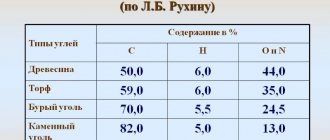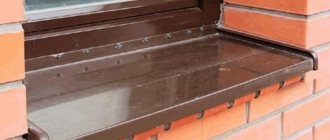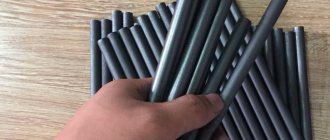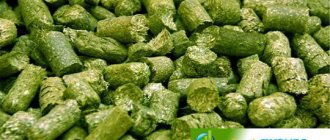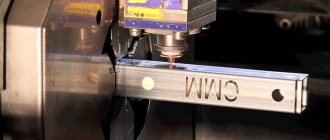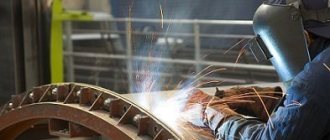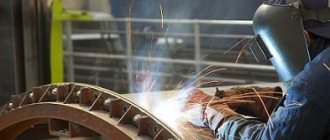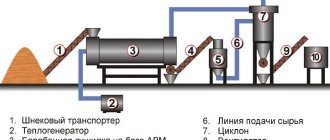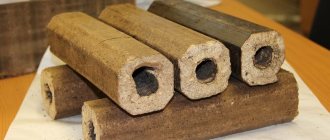While various wood wastes in the form of sawdust and wood chips are quite easy to burn in long-burning boilers specially adapted for this, the situation is different with fine coal and dust. Anyone who has ever tried to fire a stove or boiler with small fractions of coal knows that half of the fuel is wasted, spilling through the grate into the ash pan, and the other half is sintered and blocks the access of air to the firebox. Because of this, the intensity of combustion is sharply reduced. At the same time, it is stupid to throw away such fuel, because it contains a lot of thermal energy. In such a situation, coal briquetting can help, which will be discussed in this article.
Briquetting of coal dust
Coal dust and debris are formed during the mining, storage and transportation of coal. An effective way to utilize coal dust is to process it into coal briquettes.
Coal briquettes are high-quality fuel with a moisture content of 10% and high strength. Due to their low humidity, the energy value of coal briquettes is superior to the original coal; the standard size and shape of briquetted coal increases its consumer qualities. Thus, briquetting coal dust
is one of the ways to attract investment in the coal mining industry.
How can you make briquettes from coal with your own hands?
It is impossible to implement industrial technology at home. The reasons are the high price of equipment for the production of coal briquettes, high energy costs and the need to coordinate their actions with local authorities. But the owner of a private house does not need to launch a large-scale production in order to provide heating for the home. It is enough to produce 3-4 tons of coal briquettes, which will be enough for the whole winter.
Pressed coal in briquettes can be obtained in two ways:
- weld a machine for forming briquettes from rolled metal and extrude the products manually;
- assemble a screw press with your own hands to briquet coal fines using the extrusion method.
In both cases, it will not be possible to achieve characteristics close to those of factory-made fuel. But you can successfully heat your house by burning homemade briquettes instead of coal dust, which is much more convenient and practical.
Pressing by hand
For manual extrusion, a machine well known to many craftsmen for making bricks at home is suitable. Its frame is welded from profile pipes and angles 40x40 mm, and a receiving hopper is installed on top. A manual mechanism for pressing products into a rectangular shape is attached to the frame. A drawing of a homemade press for manual coal briquetting is shown in the figure:
The rectangular shape used to make bricks can be replaced with a cylindrical one, and plugged tubes can be placed inside so that there are through holes in the products. They are needed for better combustion of a charcoal briquette made by yourself.
The technology for manual coal briquetting looks like this:
- You need to try to grind the raw materials. The smaller the fraction, the stronger and better quality the homemade briquette will be.
- Pour in a little water and stir until the mixture sticks together with your hands. Some home craftsmen add clay as a binder, but this will lead to an increase in the ash content of the fuel.
- Pour the mixture into the hopper, and from there fill the mold. Press out the briquette by pressing the lever.
- During the reverse stroke, the lever pushes the product out. Afterwards it should be removed and placed in a sunny area to dry. Pressing details are shown in the video:
Briquetting on an extruder
This more productive method will require financial costs for assembling a screw press consisting of the following elements:
- a housing made of a thick-walled steel pipe, machined from the inside to the size of the auger, or made from a solid metal blank on a lathe;
- auger made of carbon steel of increased hardness;
- a matrix with one or several holes is made from the same steel;
- electric motor with a power of at least 4 kW;
- belt drive on multi-belt pulleys (at least 3 belts);
- receiving bunker.
Note. Instead of a belt drive, you can use a gear drive, but then the drive will be rigidly connected to the shaft. In the event of any accident, the gearbox or auger may fail.
The operating principle of a briquetting extruder and a homemade screw (right)
The most difficult thing to make is the body, matrix and screw. For this, it is better to turn to a familiar turner, he will also turn you multi-groove pulleys of the required sizes. Please note: the pulley diameters should be selected so that the auger rotation speed does not exceed 200 rpm. The powerful motor of the machine must be grounded and connected to the house electrical network through circuit breakers.
Small homemade extruder
The technology of briquetting on an extruder is quite simple and is implemented in several stages:
- If possible, grind the raw materials and mix with water to a thick consistency.
- Turn on the extruder motor and use a shovel to load a portion of the coal mixture into the hopper.
- Break off the “sausages” emerging from the holes of the matrix to the desired length and lay them out on a rack to dry.
The process of making fuel briquettes from coal is shown in detail in the following video:
Advantages of coal briquettes
Coal briquettes have the following advantages over original coal:
- Higher energy value (20-30%)
- Longer burning (4 times longer)
- Ash in powder form
- 22% less CO2 emissions
- Less sulfur emissions (less than 1% and can be controlled)
- Easier packaging, transportation, storage
- Ready for automatic feeding into the firebox
- Possibility of packaging for the consumer market
- Opportunities for export sales
About the benefits of coal briquettes - conclusions
If we think theoretically and take into account the assurances of coal briquette manufacturers, then in terms of calorific value they should defeat all other types of solid fuel. After all, only pure anthracite is capable of releasing 7.7-8 kW per 1 kg when burned. Firewood, pellets and wood briquettes lag far behind in terms of specific heat of combustion, since they emit no more than 5 kW/kg.
But judging by the reviews of users of solid fuel boilers on thematic forums, the demand for briquetted coal is inferior to any type of wood due to the following reasons:
- they burn poorly and give off little heat;
- form a large amount of ash, and even pebbles, repeating the shape of briquettes;
- crumble into dust during transportation;
- They emit an unpleasant odor before and during combustion.
High-quality briquettes (on the right) with their black shine are noticeably different from brown coal fuel, which does not burn very well in heating boilers and furnaces.
If you analyze all the reviews about coal briquettes, it turns out that 70% of them are negative. This is primarily due to the fact that fuel producers are trying to make a profit by using waste raw materials - sludge, charge and other obscene varieties of hard and brown coals. Briquettes pressed from anthracite residues are rare.
This suggests a conclusion: if you want to get good fuel, then use the appropriate raw materials for briquetting with your own hands. When you only have dust and fines of low-calorie coal at your disposal, pressing them is not always advisable. On the other hand, such briquettes can be burned together with firewood, reducing the cost of purchasing them.
Equipment for the production of coal briquettes
SP Bioresurs Technology LLC is the official representative in the Russian Federation of a French manufacturer of high-quality equipment for coal briquetting with a capacity of up to 100 t/h.
We offer our customers a complete set of turnkey equipment for the production of coal briquettes, consisting of:
- coal grinding and drying area
- binder addition area
- coal briquetting area
- systems for cooling, storage and packaging of coal briquettes
About coal briquetting technology
One of the ways to burn coal fines is to light the boiler with wood, and then pour the dusty fraction of fuel on top of the burning logs. But this is too troublesome, since coal dust must be added in small portions, and therefore often.
If you load a large portion, then some of the fuel will definitely spill into the ash pan and go to waste, and the rest of the fuel will fill the cracks between the wood. Air will stop flowing into the combustion zone and, as a result, the firebox will begin to fade.
The best way is to use the pressing method to form briquettes from the fine fraction, which then burn very well, releasing a large amount of heat. Such a solution as coal briquetting was proposed at the beginning of the century before last in Russia by the inventor A.P. Veshnyakov is still successfully used both for industrial purposes and in everyday life. Its essence is that the compaction of fine coal using high pressure on special equipment makes it possible to obtain fuel whose calorific value is no less than that of high-quality coal.
Without going deeply into the intricacies of the technological process and the classification of different brands of fuel, we note that such briquettes are produced in two types:
- with binders for industrial purposes;
- without binders, intended for combustion in domestic boiler systems.
Note. Briquettes pressed with binders cannot be used in everyday life. When burned, these substances form harmful or toxic compounds, which are captured in industry in various ways. Previously, starches or molasses were also added to household fuel as binders, but this technology is outdated.
Since we are interested in the technology for producing coal briquettes without any additives for household purposes, it is worth considering this. So, the sequence of the process is as follows:
- first, the coal undergoes a grinding operation, with a maximum fraction size of 6 mm allowed;
- the next operation is drying in order to achieve an optimal humidity of 15%. For this purpose, special equipment is used for the production of coal briquettes - steam or gas dryers;
- After drying, the composition is cooled and supplied for pressing. The operation takes place at a pressure of 100-150 MPa in the so-called stamp press;
- final cooling and shipment to the warehouse.
Note. The traditional technological process is described here, but the requirements for the fraction size and moisture content of the raw materials may vary depending on the equipment used. For example, a modern mini-plant of the Russian company UNITEK requires particle sizes of up to 0.25 mm with a moisture content of 6 to 16%. That is, in this case, the coal briquetting technology should provide for better grinding, but the pressing pressure is applied much lower.
The output is a coal briquette, whose ash content does not exceed 15-20%, the maximum permissible mechanical load is 3 kg/cm2, and when dropped from a height of up to 2 m, the product loses no more than 15% of its mass as a result of impact. The heat of combustion depends on the grades of coal from which the briquette is pressed.
Charcoal briquetting
When producing charcoal, about a quarter of it turns out to be substandard - small pieces and dust. To turn this waste into income, you can make briquettes from them. Charcoal briquettes can also be made at home; if necessary, you can make raw materials for this (charcoal yourself). The principle of briquetting charcoal is no different from the formation of the same fuel from coal:
- Substandard coal is crushed.
- Mix with binder. In this case, a regular starch paste will do the job well. The output should be a slightly moist mass. Some of the dust rolls into small lumps.
- The resulting mixture is fed into a press, where briquettes are formed.
This video clearly shows the entire technology of charcoal briquetting, but the guys created a form specifically for the customer (church tablets made from charcoal for incense were ordered). Similarly, you can make a mold of any configuration.
Conclusions . Briquettes from coal crumbs and dust (stone and wood) can be made at home. It is difficult to achieve commercial results (only through automation, and therefore expensive equipment), but for home use it is possible to make a simple installation.
Equipment for creating heating material
Today, there are many companies that supply equipment for the production of fuel briquettes, and often they also offer installation services. In some cases, lessons are provided on how to use the devices.
To make your own fuel you will need the following:
- for grinding recyclable materials;
- Briquetting press (hydraulic, screw or impact-mechanical;
- finished product.
If it is possible to dry the material in the fresh air or receive it dry from other industries, then you can do without a drying complex, but it should be taken into account that the sawdust should have a moisture content of no more than 13%. And when using sawdust, you don’t need a crusher.
Briquette production
The raw materials for the production of briquettes are all kinds of waste from agricultural enterprises, woodworking, furniture production and other industrial sectors where wood and plants are used. The technology for producing fuel briquettes from sawdust makes it possible to consume up to four cubic meters of waste to create one cubic meter of finished product, which has a positive effect on the environment. Companies that produce environmentally friendly firewood are saving the planet from a huge amount of waste.
The cost of briquetting raw materials varies depending on its type and quality, as well as the region from which it is delivered. The quality of the supplied raw materials is one of the main factors for the success of the production of environmentally friendly clean fuel. It is important to have reliable suppliers who, in accordance with laws and regulations, ensure environmental safety in their production. Numerous agricultural complexes and farms, wood processing enterprises and sawmills become such suppliers.
The technology for producing environmentally friendly fuel is divided into several stages. At each of them, special equipment is used, and established temperature and pressure standards are observed. But the main element when creating briquettes is the binding agent. The connecting components are melted during the production process and bind together the fractions of raw materials.
Deciduous wood waste does not require the addition of binding agents because it already contains resin, which becomes a binding element when heated. Agricultural waste, on the other hand, requires additional substances such as lignin. Lignin is considered a basic component in fuel briquettes. Its composition is environmentally friendly, as it is obtained only from the remains of plant parts.
The production of environmentally friendly firewood begins with preparing the drying apparatus and setting the desired temperature inside the fan. After this, a screw-fed hopper is loaded, feeding the material into the drying chamber. Moisture is removed by air currents, so only ordinary steam escapes into the atmosphere. When drying the material, no harmful substances are released, which is why the production of fuel briquettes is called environmentally friendly.
Manufacturing stages
Main manufacturing stages:
- Grinding/crushing of raw materials to a fraction of no more than 3 mm. The waste is crushed in a chipper. The machine's rotating drum, equipped with sharp knives, crushes the chips and separates larger ones for re-grinding to the required size.
- Drying. The heat generator dries the fractions with hot air. The amount of moisture in the raw material should not exceed 15%.
- Briquetting. The line for briquetting wood waste begins in the extruder, and not only that. The prepared mixture is sent for pressing. Under high pressure and at special temperatures, the raw material is extruded from the extruder and cut into individual briquettes.
- Package. The briquettes are hermetically packaged, after which they are sent to the warehouse.
Manufacturing equipment
The main equipment for the production of fuel briquettes is an extruder and a press.
An extruder is a machine that softens/melts materials and gives them the desired shape by squeezing the compressed mass through a die. The machine consists of several main fragments: a housing with a heating element, a main screw and an extrusion head for creating briquettes of a certain shape at the exit of the machine.
The press is a device for squeezing a prepared mixture of fractions to a high density and ergonomic consistency. Compression allows you to form briquettes that are as compact as possible and suitable for long-term storage and use.
There are several types of press:
- Manual press for briquettes. This is a simple metal structure that includes a mold, a supporting part, a piston and a handle. This type of press is light weight and easy to transport.
- Hydraulic Press. The hydraulic press includes a variable displacement piston pump, an electric motor and a hydraulic oil tank. Used only in rooms where above-zero temperatures are maintained.
- Mechanical impact press. Forms briquettes using the principle of impact extrusion. The press piston is placed horizontally inside a cylindrical pump.
Types of briquetting devices
The main equipment for the production of Euro-firewood, with the help of which their formation occurs, can be of various types, both in terms of the type of drive used, and in terms of design and principle of operation. So, in the simplest version, to make fuel briquettes with your own hands, you can use a homemade press equipped with a screw, lever or hydraulic drive. For the production of Euro firewood, the production of which is organized on an industrial scale, universal extruder-type machines are used.
Homemade press for making briquettes
Manual machines
In order to periodically produce a small amount of eurowood for your own needs, you can use a manual briquette making machine, which is driven by a screw, lever or hydraulic mechanism. The basis of such a machine, a drawing of which is easy to find on the Internet, is the frame. All other structural elements are fixed to the frame:
- a matrix, for the manufacture of which a thick-walled pipe of the appropriate diameter can be used;
- a punch made of a thick metal sheet, to which a pipe is welded, performing the functions of a rod;
- a mixing drum, which can be made from a large diameter pipe or sheet of tin, forming it into a cylinder of the appropriate size;
- a drive mechanism, which can be a screw with a handle, a lever or an automobile hydraulic jack;
- trays for loading raw materials and unloading finished products.
The device of a manual machine for fuel briquettes
The principle by which such a home-made briquetting plant works is quite simple: the raw material, mixed with a binder in the drum, is loaded into the cavity of the matrix, where pressure begins to be exerted on it by a punch; After the briquette is formed, it is unloaded through the lower part of the matrix, which is equipped with an opening bottom. Briquettes produced on such a machine must be dried in an oven or in the open air. Only after this can they be used for their intended purpose.
Extruder type briquetting plant
When producing briquettes in production conditions, as mentioned above, extruder-type machines are used. The raw material fed into the working chamber of such a device is captured by a rotating screw and moves to the holes of the matrix. When pressed through such holes under high pressure, granules with a dense internal structure are formed from the raw material.
Hydraulic equipment for briquetting, unlike mechanical machines, is more unpretentious to raw materials
When using this machine, no binders are added to the raw materials for the production of briquettes, since the pressure created is quite sufficient for lignin to be released from the sawdust mass. After the fuel pellets are produced by the extruder, they are cooled, dried and packaged.
Advantages of using fuel briquettes
Fuel briquettes are solid fuel produced by pressing various types of pre-crushed raw materials, which can be used:
- sawdust and shavings;
- tree bark, foliage and needles;
- straw and reeds;
- peat and coal dust;
- bird droppings;
- paper and cardboard.
The most popular among consumers due to their fairly high heat transfer, as well as a number of other advantages, are fuel briquettes made from sawdust.
The key to high calorific value of briquettes is high density and low humidity
What are the advantages of wood briquettes over regular firewood?
- The burning time of sawdust briquettes is at least twice as long as the period during which ordinary firewood burns.
- The amount of ash remaining after complete combustion of wood briquettes averages about 1% of the total mass of fuel used.
- When burning, briquettes practically do not spark and emit a minimal amount of smoke.
Fuel briquettes burn almost completely, leaving only a small amount of ash
In addition, it should be noted that such fuel is environmentally safe, since sawdust briquetting in industrial conditions practically does not use additional chemicals that can harm human health and the environment.
The most common applications for sawdust briquettes are:
- heating of private houses and cottages;
- ensuring the functioning of medium-power boiler houses, with the help of which buildings for various purposes are heated;
- use as a filler for cat litter, as well as for localizing and removing moisture from any place in the house.
Among the advantages of fuel briquettes, one should also highlight their compactness, which makes it easy to transport and store this type of fuel.
One pallet of briquettes takes up several times less space than firewood that can produce the same amount of heat
Production technology
The production of European firewood, no matter what machines are used for these purposes - homemade or industrial, is carried out using proven technology.
- Raw materials for the production of briquettes are cleaned of foreign impurities and sent for preliminary grinding. This is necessary in order to speed up the drying process of the bulk raw material mass.
- After preliminary grinding, the mass for the production of fuel briquettes is sent to a drying drum, where the moisture content of the raw materials is adjusted to a level of 8–12%.
- The raw material, brought to the required moisture level, is subjected to final grinding.
- After repeated grinding, the loose raw material mass is briquetted, during which significant pressure is applied to it. As a result, a natural substance is released from the sawdust mass, acting as a binding component - lignin.
- After the formation of briquettes, which spontaneously heat up under the influence of significant pressure exerted on them, they are subjected to cooling and final drying, and then packaging.
Schematic representation of the production of fuel briquettes
When making briquettes not on an industrial machine, but using homemade products that cannot create pressure sufficient to separate lignin from the sawdust mass, binders are added to the raw material mass. For this function, ordinary clay, wallpaper glue, soaked paper, cardboard, etc. can be used.
Press for making fuel briquettes with your own hands
The purchase of ready-made equipment for the production of briquettes, depending on its capacity, will cost from 300 thousand to 1 million rubles.
Of course, for a private owner who wants to start producing this fuel purely for his own needs, such costs are impractical, since they will not pay off soon. It would be more correct to make a press from scrap materials, especially since there is nothing complicated in its design.
You can build the necessary equipment from scratch or use ready-made mechanisms.
Homemade machine
Making an installation from scratch
You can create the significant force required to compress raw materials using:
- lever (you can act on it with your own weight);
- screw mechanism.
A lever press can even be made from wood; for a screw press, you will definitely need steel blanks and a lathe.
A screw extruder (press for sawdust) can theoretically also be made with your own hands, and some craftsmen have even succeeded, but such an undertaking is very expensive due to the complex processing of parts and the need to use special high-quality steel.
Heating with pellets is not only economical, but also environmentally friendly, because recycled materials are used as fuel. You can make or convert a solid fuel tank for pellets.
You will find detailed instructions for making a solid fuel boiler with your own hands.
Are you unsure about choosing a pellet boiler? Follow this link: you will find reviews from real users about these boilers. Read and draw conclusions.
Manufacturing a press based on a ready-made mechanism
To make briquettes, you can use some device that is more accessible than a real machine - a jack or a small hydraulic press. All that remains is to equip it with a punch and a matrix.
It should be understood that any homemade press, even one made on the basis of a hydraulic jack, will not be able to develop the forces that ensure the release of lignin. Therefore, instead of it, third-party binders have to be added to the raw material.
In this capacity they use:
- Cheap glue, for example, wallpaper.
- Clay (add 1 part to 10 parts sawdust).
- Soaked paper, including corrugated cardboard - the lignin contained in it, when in contact with moisture, exhibits its adhesive properties (this property of paper is used when spraying a heat insulator like "Ecowool").
Another difference from industrial technology is that the source material is not dried, but rather soaked in water - then the particles stick together better. Then the finished briquette is dried in the open air.
How to grind raw materials
In the hassle of making a homemade press, we must not forget about such an important stage in the production of briquettes as grinding the raw materials. It is very difficult to cut it by hand - mechanization is also necessary here
Some people make shredders themselves from an old activator washing machine - they install knives instead of the activator.
Another option is to purchase a rotary machine.
The purpose of this device is precisely to chop vegetation - summer residents use it to make fertilizers from leaves and grass.
Types of briquettes
Eurofirewood differs both in appearance and composition. Eco-friendly firewood is created in three types of standard shapes.
By shape
Depending on the shape and pressure of the press with which they were made.
Briquettes RUF
Rectangular "RUF". To compress them, hydraulic presses with a pressure of 350 to 400 bar are used. The rectangular shape of the briquettes, reminiscent of a brick, simplifies their transportation and long-term storage.
Briquettes Nestro
Cylindrical "NESTRO". When forming them, shock-mechanical and hydraulic presses are used, in which the pressure reaches 600 bar. Such fuel pellets have low moisture resistance.
Briquettes Pini&Kay
Multifaceted (extruded) “Pini&Kay”. This species is distinguished by radial holes in the center and a characteristic dark color; are manufactured at high temperatures up to 200-300 C and mechanical press pressure up to 1100 bar. They are characterized by high resistance to moisture and mechanical stress.
By composition
Based on their composition, fuel briquettes are also divided into several types:
- Woody. The raw materials for them are all waste from processing wood products: shavings, chips, sawdust, bark, slabs.
- From agricultural waste. Cereal husks, corn and sunflower waste, peat, charcoal - all this turns into raw materials for European firewood. They do not have such high heat transfer as other types.
- Coal. Briquettes made from coal dust are the best in terms of heat transfer.
Production of briquettes in small industries
The following pressing technologies are used in industry:
- Using hydraulic presses (the output is heating material in the form of bricks);
- On impact-mechanical presses (cylindrical briquettes);
- Under the influence of high temperature and pressure using mechanical (screw) presses (in the form of a polyhedron).
As a result of pressing, lignin is released from the wood itself, which acts as a gluing agent. It is impossible or very difficult to achieve such results with homemade presses and you need to use clay or another binding material, such as shredded paper.
Equipment for pressing raw materials
As it becomes clear from the description of the technological process, to organize the full-fledged production of fuel briquettes, a whole complex of technical devices is needed. This includes:
- drying equipment, which is mainly used drum-type installations;
- machine for grinding raw materials;
- equipment for forming briquettes, which can be a production line or a separate press for sawdust and other raw materials.
Diagram of an impact briquette production line complete with a chopper and a drying unit
Both the composition of production lines for the production of fuel briquettes and the type of equipment with which they are equipped are selected depending on the planned production volumes and the type of raw materials used.
In addition to the main equipment, briquette production lines are equipped with auxiliary technical devices:
- belt or screw type conveyors, which provide transportation of raw materials and finished products;
- storage hopper with dosing device and agitator;
- magnetic type traps, which ensure the extraction of metal impurities from the raw material, if they are present in it;
- vibration type sorter;
- calibrators, with the help of which particles of the wrong size are screened out from raw materials;
- fans;
- packaging installation equipped with weighing equipment.
A modern technological line for the production of briquettes is characterized by low energy intensity and pays for itself in a short time
Among all the technological equipment used for the production of Euro-firewood, the most important role is played by briquetting machines, with the help of which a briquette is formed from a crumbly sawdust mass, characterized by a high density of internal structure.
